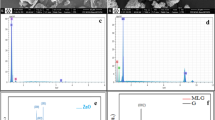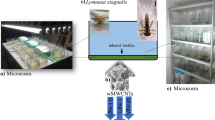Abstract
The reaction of bivalves Modiolus modiolus to pulse (for 24 and 48 h) exposure with multiwalled carbon nanotubes (MWCNTs) (12–14 nm, MWNT concentration in sea water of 100 mg/L) is manifested in the ingestion of MWCNT aggregates formed in seawater despite their rapid sedimentation from the water column to the bottom of the aquariums. After 24 h, the MWCNT aggregates are observed in the intestinal lumen (size of 10 to 150 μm) and in the tubules of the digestive gland (10 to 50 μm). After 48 h, only large aggregates in contact with mucus and desquamated epithelium fragments are detected in the lumen of the intestine. The smallest aggregates seem to be inside epithelial cells. In the intestine, digestive gland, and gills, MWCNT aggregates induce histopathological changes in the epithelium (erosion, necrosis, trend towards increased vacuolization of the cells) and swelling of the connective tissue. In the gill epithelium after 48 h, patterns morphologically corresponding to apoptosis are observed. Despite significant organ damage, no change in the cellular composition of the hemolymph in mussels exposed to the MWCNTs is found.
Similar content being viewed by others
References
A. Vianello, A. Boldrin, P. Guerriero, et al., “Microplastic particles in sediments of Lagoon of Venice, Italy: first observations on occurrence, spatial patterns and identification,” Estuarine, Coastal Shelf Sci. 130, 54–61 (2013).
J. A. Ivar Do Sul and M. F. Costa, “The present and future of microplastic pollution in the marine environment (review),” Environ. Pollut. 185, 352–364 (2014).
M. N. Moore, “Do nanoparticles present ecotoxicological risks for the health of the aquatic environment?,” Environ. Int. 32, 967–976 (2006).
A. Baun, N. B. Hartmann, K. Grieger, and K. O. Kusk, “Ecotoxicity of engineered nanoparticles to aquatic invertebrates: a brief review and recommendations for future toxicity testing,” Ecotoxicology 17 (5), 387–395 (2008).
K. Tiede, M. Hassellov, E. Breitbarth, et al., “Considerations for environmental fate and ecotoxicity testing to support environmental risk assessment for engineered nanoparticles,” J. Chromatogr. 1216 (3), 503–509 (2009).
L. Canesi, C. Ciacci, R. Fabbri, et al., “Bivalve mollusks as a unique target group for nanoparticle toxicity,” Marine Environ. Res. 76, 16–21 (2012).
J. E. Ward and D. J. Kach, “Marine aggregates facilitate ingestion of nanoparticles by suspension feeding bivalves,” Marine Environ. Res. 68, 137–142 (2009).
E. Oberdörster, “Manufactured nanomaterials (fullerenes, C60) induce oxidative stress in the brain of juvenile largemouth bass,” Environ. Health Perspect. 112, 1058–1062 (2004).
F. Gagnè, J. Auclair, P. Turcotte, et al., “Ecotoxicity of Cd-Te quantum dots to freshwater mussel: impacts on immune system, oxidative stress and genotoxicity,” Aquatic Toxicol. 86, 333–340 (2008).
A. Koehler, U. Marx, K. Broeg, et al., “Effects of nanoparticles in Mytilus edulis gills and hepatopancreas–a new threat to marine life?,” Marine Environ. Res. 66, 12–14 (2008).
S. Tedesco, H. Doyle, G. Redmond, and D. Sheehan, “Gold nanoparticles and oxidative stress in Mytilus Edulis,” Marine Environ. Res. 66, 131–133 (2008).
A. H. Ringwood, N. Levi Polyachenko, and D. L. Carroll, “Fullerene exposures with oysters: embryonic, adult, and cellular responses,” Environ. Sci. Technol. 43, 7136–7141 (2009).
T. Galloway, C. Lewis, I. Dolciotti, et al., “Sublethal toxicity of nano-titanium dioxide and carbon nanotubes in a sediment dwelling marine polychaete,” Environ. Pollut. 158, 1748–1755 (2010).
E. J. Petersen, R. A. Pinto, D. J. Mai, et al., “Influence of polyethyleneimine graftings of multi-walled carbon nanotubes on their accumulation and elimination by and toxicity to Daphnia magna,” Environ. Sci. Technol. 45, 1133–1138 (2011).
C. Falugi, M. G. Aluigi, M. C. Chiantore, et al., “Toxicity of metal oxide nanoparticles in immune cells of the Sea Urchin,” Marine Environ. Res. 76, 114–121 (2012).
P.-E. Buffet, M. Richard, F. Caupos, et al., “A mesocosm study of fate and effects of CuO nanoparticles on endobenthic species (Scrobicularia Plana, Hediste Diversicolor),” Environ. Sci. Technol. 47 (3), 1620–1628 (2013).
P.-E. Buffet, A. Zalouk-Vergnoux, A. Châtel, et al., “A marine mesocosm study on the environmental fate of silver nanoparticles and toxicity effects on two endobenthic species: the ragworm Hediste diversicolor and the bivalve mollusc Scrobicularia plana,” Sci. Total Environ. 470–471, 1151–1159 (2014).
C. Jacobasch, C. Völker, S. Giebner, et al., “Long-term effects of nanoscaled titanium dioxide on the cladoceran Daphnia magna over six generations,” Environ. Pollut. 186, 180–186 (2014).
V. Moschino, N. Nesto, S. Barison, et al., “A preliminary investigation on nanohorn toxicity in marine mussels and polychaetes,” Sci. Total Environ. 468–469, 111–119 (2014).
R. C. Murdock, L. Braydich-Stolle, A. M. Schrand, et al., “Characterization of nanomaterial dispersion in solution prior to in vitro exposure using dynamic light scattering technique,” Toxicol. Sci. 101 (2), 239–253 (2008).
D. B. Warheit, “How meaningful are the results of nanotoxicity studies in the absence of adequate material characterization?,” Toxicol. Sci. 101 (2), 183–185 (2008).
V. Matranga and I. Corsi, “Toxic effects of engineered nanoparticles in the marine environment: model organisms and molecular approaches,” Marine Environ. Res. 76, 32–40 (2012).
L. M. Oliver and W. S. Fisher, “Appraisal of prospective bivalve immunomarkers,” Biomarkers 4 (6), 510–530 (1999).
M. Auffret, “Bivalves as models for marine immunotoxicology,” in Investigative Immunotoxicology, Ed. by H. Tryphonas, M. Fournier, B. R. Blakley, J. E. G. Smits, and P. Brousseau (Taylor & Francis, Boca Raton, 2005), pp. 29–48.
A. Dagnino, J. I. Allen, M. N. Moore, et al., “Development of an expert system for the integration of biomarker responses in mussels into an animal health index,” Biomarkers 12, 155–172 (2007).
A. A. Anisimova, “Morphofunctional parameters of hemocytes in assessment of the physiological status of bivalves,” Russ. J. Marine Biol. 39 (6), 381–391 (2013).
C. Barmo, C. Ciacci, B. Canonico, et al., “In vivo effects of N-TiO2 on digestive gland and immune function of the marine bivalve Mytilus galloprovincialis,” Aquatic Toxicol. 132–133, 9–18 (2013).
A. D’Agata, S. Fasulo, L. J. Dallas, et al., “Enhanced toxicity of ‘bulk’ titanium dioxide compared to ‘fresh’ and ‘aged’ nano-TiO2 in marine mussels (Mytilus galloprovincialis),” Nanotoxicology 8 (5), 549–558 (2014).
M. A. Browne, A. Dissanayake, T. S. Galloway, et al., “Ingested microscopic plastic translocates to the circulatory system of the mussel, Mytilus edulis (L),” Environ. Sci. Technol. 42, 5026–5031 (2008).
L. Canesi, G. Gallo, M. Gavioli, and C. Pruzzo, “Bacteria-hemocyte interactions and phagocytosis in marine bivalves,” Microscopy Res. Techn. 57, 469–476 (2002).
P. G. Tiscar and F. Mosca, “Defense mechanisms in farmed marine mollusks,” Vet. Res. Commun. 28, 57–62 (2004).
L. Donaghy, C. Lambert, K.-S. Choi, and P. Soudant, “Hemocytes of the carpet shell clam (Ruditapes decussatus) and the Manila clam (Ruditapes philippinarum): current knowledge and future prospects,” Aquaculture 297, 10–24 (2009).
V. L. Kuznetsov, K. V. Elumeeva, A. V. Ishchenko, et al., “Multi-walled carbon nanotubes with PPM level of impurities,” Phys. Status Solidi B 247 (11–12), 2695–2699 (2010).
V. L. Kuznetsov, D. V. Krasnikov, A. N. Schmakov, and K. V. Elumeeva, “In situ and ex situ time resolved study of multi-component Fe-Co oxide catalyst activation during MWNT synthesis,” Phys. Status Solidi B 249, 2390–2394 (2012).
L. Canesi, C. Ciacci, D. Vallotto, et al., “In vitro effects of suspensions of selected nanoparticles (C60 fullerene, TiO2, SiO2) on Mytilus hemocytes,” Aquat. Toxicol. 96, 151–158 (2010).
L. Canesi, R. Fabbri, G. Gallo, et al., “Biomarkers in Mytilus galloprovincialis exposed to suspensions of selected nanoparticles (nano carbon black, C60 fullerene, nano-TiO2, nano-SiO2),” Aquat. Toxicol. 100, 168–177 (2010).
A. P. Roberts, A. S. Mount, B. Seda, et al., “In vivo biomodification of lipid-coated carbon nanotubes by Daphnia magna,” Environ. Sci. Technol. 41, 3025–3029 (2007).
M. C. Mix, “A general model for leukocytes cell renewal in bivalve mollusks,” Marine Fish. Rev. 38 (10), 37–41 (1976).
E. Ottaviani, A. Franchini, D. Barbieri, and D. Kletsas, “Comparative and morphofunctional studies on Mytilus galloprovincialis hemocytes: presence of two agingrelated hemocyte stages,” Italian J. Zool. 65 (4), 340–354 (1998).
E. Garcia-Garcia, M. Prado-Alvarez, B. Novoa, et al., “Immune responses of mussel hemocyte subpopulations are differentially regulated by enzymes of the PI 3-K, PKC, and ERK kinase families,” Develop. Comparative Immunol. 32, 637–653 (2008).
A. A. Anisimova, “Flow cytometric and light microscopic identification of hemocyte subpopulations in Modiolus kurilensis (Bernard, 1983) (Bivalvia: Mytilidae),” Russ. J. Marine Biol. 38 (5), 406–415 (2012).
H. Hégaret, P. M. da Silva, G. H. Wikfors, et al., “Hemocyte responses of manila clams, Ruditapes philippinarum, with varying parasite, Perkinsus olseni, severity to toxic-algal exposures,” Aquat. Toxicol. 84, 469–479 (2007).
P. M. Da Silva, H. Hégaret, C. Lambert, et al., “Immunological responses of the manila clam (Ruditapes philippinarum) with varying parasite (Perkinsus olseni) burden, during a long-term exposure to the harmful alga, Karenia selliformis, and possible interactions,” Toxicon 51, 563–573 (2008).
E. Galimany, A. R. Place, M. Ramón, et al., “The effects of feeding Karlodinium veneficum (PLY # 103; Gymnodinium veneficum Ballantine) to the blue mussel Mytilus edulis,” Harmful Algae 7 (1), 91–98 (2008).
Author information
Authors and Affiliations
Corresponding author
Rights and permissions
About this article
Cite this article
Anisimova, A.A., Chaika, V.V., Kuznetsov, V.L. et al. Study of the influence of multiwalled carbon nanotubes (12–14 nm) on the main target tissues of the bivalve Modiolus modiolus . Nanotechnol Russia 10, 278–287 (2015). https://doi.org/10.1134/S1995078015020020
Received:
Accepted:
Published:
Issue Date:
DOI: https://doi.org/10.1134/S1995078015020020




